The city of Lille
More than one thousand year old, the city of Lille, capital of northern France, is the core of the fourth largest urban area in France with Paris, Lyon and Marseilles. Once the center of a industrial region devoted to mining, textile (cotton, wool), metallurgy and chemistry, Lille is quickly becoming a major european city and a busy business place with Paris, London et Brussels less than 90 minutes away by train. European Capital of Culture in 2004, Lille attracts many tourists which fall under the charm of its lively atmosphere and of its old town, mostly dating from the 17th and 18th centuries, with some buildings going back to the 15th century.
A short History
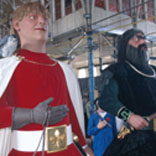 The oldest written mention of Lille in archives dates back to the beginning of last millenium, when the city began to expand, but there is archeological evidence that the area has been inhabited since prehistoric times. The area was part of the Belgian Gaul inhabited by the Nervii, a tribe of germanic origin described by Julius Caesar, who fought for four years in Northern France and Belgium, as the "bravest of all gauls". As for the name, tradition has it that L'isle (also L'isla or insula, island in latin) was the name of a castle built on a piece of dry land in a marshy area, where Lydéric, first count of Flanders, settled in 640.
The oldest written mention of Lille in archives dates back to the beginning of last millenium, when the city began to expand, but there is archeological evidence that the area has been inhabited since prehistoric times. The area was part of the Belgian Gaul inhabited by the Nervii, a tribe of germanic origin described by Julius Caesar, who fought for four years in Northern France and Belgium, as the "bravest of all gauls". As for the name, tradition has it that L'isle (also L'isla or insula, island in latin) was the name of a castle built on a piece of dry land in a marshy area, where Lydéric, first count of Flanders, settled in 640.
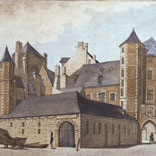 Tournai (Belgium), capital of the frankish kingdom that eventually gave birth to France, is only 30 kilometers away. However it is only in 1667 that Lille finally became part of France, after knowing many rules. It was besieged and put into flames by King of France Philippe Auguste in 1213, one year before the famous battle of Bouvines (5 km away from Villeneuve d'Ascq). Rebuilt by Countess Jeanne of Flanders, Lille was besieged again by french King Philippe le Bel in 1297 and was under french rule from 1304 to 1369, during which Flanders were a strategic location in the Hundred Years's War between England and France.
Tournai (Belgium), capital of the frankish kingdom that eventually gave birth to France, is only 30 kilometers away. However it is only in 1667 that Lille finally became part of France, after knowing many rules. It was besieged and put into flames by King of France Philippe Auguste in 1213, one year before the famous battle of Bouvines (5 km away from Villeneuve d'Ascq). Rebuilt by Countess Jeanne of Flanders, Lille was besieged again by french King Philippe le Bel in 1297 and was under french rule from 1304 to 1369, during which Flanders were a strategic location in the Hundred Years's War between England and France.
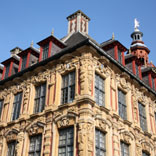 In 1369, Lille and the county of Flanders became part of the mighty Duchy of Burgundy, Lille being one its three capitals with Dijon and Bruxelles (what remains of Rihour Palace dates back to this time). At the death of the last Duke of Burgundy in 1477, his daughter married Maximilian of Austria who became count of Flanders. Lille was thus part of the Holy Roman Empire until the abdication of Charles V in 1556, and of the spanish Kingdom thereafter, until 1667 where the french Sun-King Louis XIV laid siege to Lille. After that, it was occupied by the Dutch in 1708-1713, besieged by Austrians during the french Revolution, and occupied by the Germans in 1914 and 1940.
In 1369, Lille and the county of Flanders became part of the mighty Duchy of Burgundy, Lille being one its three capitals with Dijon and Bruxelles (what remains of Rihour Palace dates back to this time). At the death of the last Duke of Burgundy in 1477, his daughter married Maximilian of Austria who became count of Flanders. Lille was thus part of the Holy Roman Empire until the abdication of Charles V in 1556, and of the spanish Kingdom thereafter, until 1667 where the french Sun-King Louis XIV laid siege to Lille. After that, it was occupied by the Dutch in 1708-1713, besieged by Austrians during the french Revolution, and occupied by the Germans in 1914 and 1940.
With such a complex history and all the prints left here, all attendees should feel at home...
More details on the history of Lille...
A few highlights
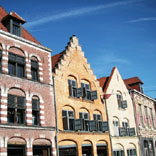
Vieux Lille (Old Lille)
Remarkably restored, the Old Town enchants the eye with its flamboyant architecture. The softly dare facades that set off the exuberance and profusion of their decoration. The extraordinary diversity of the 17th century architecture is an invitation to saunter ; so look up to appreciate the perfect harmony of brick and stone.
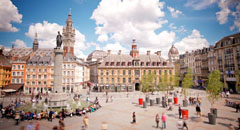
Grand Place (Main square)
The Lillois ' favourite meeting place offers an interesting view of the architecture from the 17th to the 20th century. Standing in the centre of the squares stands the Goddess commemorates Lille's resistance to the Austrian siege in 1792. In front of the Old Stock Exchange built from 1652 to 1653, is undoubtly the town's finest building. This building is made up fo 24 little houses around an arched courtyard. A second-hand book market as well as chess players can be seen inside. On this square is situated the Grand Garde. The building was used to house soldiers from the sentry guard. It is now the Théâtre du Nord.
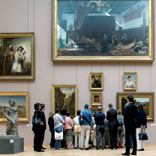
Palais des Beaux-Arts (Fine arts Museum)
The Palais des Beaux-Arts of Lille (Fine Arts Museum) one of the first museums in France, houses in its imposing 19th century building collections of European paintings, a collection of Antiquities , a mediaeval an Renaissance collection, 17th and 18th century ceramics, 19th century French sculptures ans 18th century scale models of fortified towns.

Vieille Bourse
The Vieille Bourse (Old stock exchange), built from 1652 to 1653, is undoubtly the town's finest building. This building is made up of 24 little houses around an arched courtyard. A second-hand book market as well as chess players can be seen inside. In summer, tango demonstration.
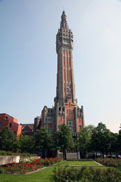
The town hall and the Belfry
It was built from 1924 to 1932 by the architect Emile Dubuisson who was inspired by the triangular-gabled Flemish houses. Its 104 meters-high belfry is listed as a Unesco World Heritage Site.
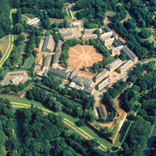
The Citadel
This is the work of Sébastien Le Preste, Marquis of Vauban. Carried out of the order of Louis XIV, who had just conquered the town. Its construction lasted from 1667 until 1670. It was really a little town surrounded by five bastions in the form of a star.

Palais Rihour
Begun in 1453 by Philippe Le Bon, Duke of Burgundy, it is one of the rare reminders of the flamboyant gothic style in Lille. On the ground floor, the Salle des Gardes (Guards room) houses the tourist office. Upstairs, the Salle du Conclave (Conclave chamber) and the sacristy with the stained glass windows welcome events.

Euralille
Inaugurated en 1994, this "new part of town" with futuristic lines is centered around the TGV High Speed Train Station Lille Europe, the Lille Grand Palais ( convention center, exhibition hall and auditorium) and the Euralille shopping centre. Several renowned architects and urban planners have collaborated in its creation : Rem Koolhas, Jean Nouvel, Christian de Portzamparc, Claude Vasconi....
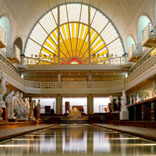
La Piscine, Museum of art and industrie in Roubaix
In the exceptional surroundings of what used to be A.Baert's 1932 Art Déco swimming baths, the Museum of Art and Industry offers its visitors an original setting for its collections of applied arts ( drawings, textiles and ceramics) and fine-arts ( 19th and 20th Centuries paintings and sculptures).
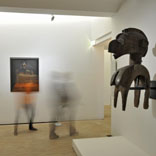
LaM in Villeneuve d'Ascq
With a prestigious collection of modern art (Braque, Kandinsky, Klee, Léger, Miro, Modigliani, Picasso), a reference for contemporary art (Boltanski, Buren, Deacon, McCollum, Messager) and the largest collection of outsider art in France (Corbaz, Darger, Forestier, Lesage, Wölfli) the LaM is a major museum of 20th century art in the north of Europe.
More details on the monuments and museums of Lille
More details on the parks and gardens of Lille
Lille Tourist Office home page